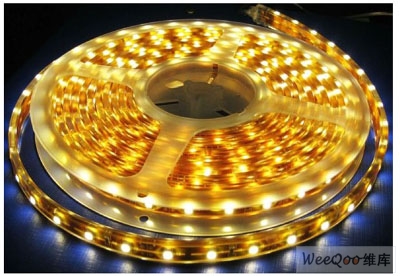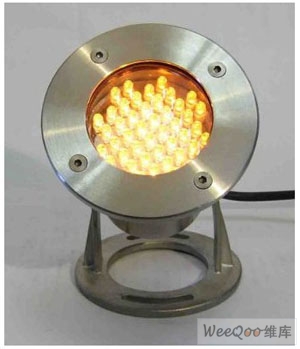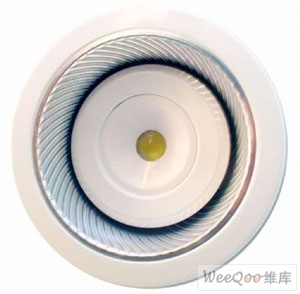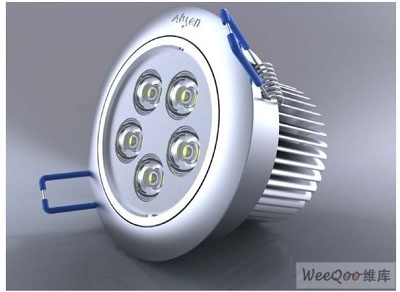LED (Light Emitting Diode) solid-state lighting is a future industry that is considered to have great potential in recent years, because consumers and industry are looking forward to using LED solid-state lighting to solve a lot of energy waste in inefficient light source lighting problems, precisely because of LED With the advantages of small size, high luminous efficiency, and power saving, most people also have high hopes for the future development of LED solid-state lighting.

Figure 1: LED strip light is made of flexible and flexible plastic material joint, which can be used to create a situational auxiliary light source design.

Figure 2: LED bulbs have limited circuit space available, and can be integrated with power ICs and safety-controlled wafers to reduce PCB size and minimize design requirements.
Because LED solid-state lighting is different from the traditional light source technology, it has many advantages in environmental protection and energy saving. Firstly, observe the common daily lighting sources, which are nothing more than incandescent lamps and fluorescent lamps. Incandescent lamps basically perform in luminous efficiency. That is to say, it tends to be inferior. Even if it has the advantages of low cost and established habits, it has become an environmentally friendly and inefficient lighting product under the social atmosphere of environmental protection. In terms of fluorescent lamps, although photovoltaic technology using high-frequency gas discharge to achieve power-saving benefits, in fact, the fluorescent lamp control process can not avoid mercury harmful to the environment, and is not the best light source choice in environmental protection appeal.
Back to the development of LED solid-state light source, early LEDs are mostly used for indicating light sources, such as medium/low brightness and low power driving light source applications such as signal lights and indicator lights. Therefore, there is no heat dissipation consideration, and on the other hand, the indicator light source. It is only used to identify the current status of the device and the status of the switch. It is not for lighting purposes, because the driving power is not high, and there is no obvious heat problem to be solved. However, the problem is that the purpose of using high-brightness LEDs is mostly to develop for alternative environmentally friendly light sources. This design method will have many effects.
When the LED solid-state light source is thinking in the direction of daily lighting application, there will be a problem of insufficient brightness. It is necessary to try to increase the power and increase the luminous efficiency on the LED component, or use a larger number of high-brightness LEDs for modular design. The light source has the requirement of "high brightness" for lighting applications.

Figure 3: The most direct way to enhance the brightness of the luminaire is to increase the number of LED illuminating components. These luminaires are made of a full metal casing for heat dissipation.
High-performance, environmentally-friendly lighting efficiency is a key to thermal design
The core design of the LED component is to use a voltage applied to the LED die to produce a light-emitting result. Similar to a conventional silicon wafer, the LED chip will also have a light decay phenomenon due to long-term use. Most designs are designed to enhance the component. The brightness of the light is increased by increasing the bias of the crystal, that is, increasing the power of the electric energy applied to the LED, so that the wafer can excite higher brightness. Thus, strengthening the power of the LED will also accelerate the problem of light decay and lifetime of the crystal. The appearance of even the high temperature of the component itself due to the enhancement of brightness can also shorten the life of the product.
When the brightness of a single LED die increases, the wattage of a single LED will increase from 0.1W to 1, 3, or even 5W. However, most LED light source modules will be analyzed and analyzed, and package modules will also appear. The thermal impedance is increased by increasing the luminous efficiency, and generally increases from 250K/W to 350K/W.

Figure 4: At present, the brightness of a single LED continues to increase, and there is also a recessed light design with a single LED high-brightness light source and a simplified power module.
The inspection test results will show that the LED will also have a decrease in "power" and "lifetime", which will cause the LED light source component, which may have a lifetime of 20,000 hours, to be reduced to only 1,000 due to heat dissipation. Hours of service life. In particular, the component maintains an optimum lifetime of 20,000 hours at an operating temperature of 50 degrees Celsius, but when the LED component operates at 70 degrees Celsius, the average lifetime is reduced to 10,000 hours, if it continues at 100 degrees Celsius. Running down, life will only be 5,000 hours.
Thermal impedance status of LED module design
In addition to the critical component LEDs are susceptible to temperature, most of the light source design has also been developed using modular concepts. Even in order to replace the traditional light source, the light-emitting components and electronic circuits can only be integrated in a very small space because the LEDs are DC-DC drive components. Most of the lamps are connected to AC Power Supply . In order to simplify the application of LED light source, the current mainstream practice is to directly integrate the power rectifier, transformer module and LED lighting components, but the problem is because The available circuit space is relatively small. When the convection space in the device is relatively small, it is naturally unable to obtain a better heat dissipation effect, and the heat dissipation process of the module can only be performed through the active countermeasures for forced heat dissipation. .
If the heat flow model is observed by the thermal impedance module, the temperature of the LED die is predicted, the junction point means the pn junction of the semiconductor, and the thermal impedance R is defined as the temperature difference and the corresponding power dissipation ratio, and the thermal impedance. The formation factors are quite a lot, but through the inspection method of the heat flow model, it can be more clearly confirmed that the heat dissipation treatment is because of which key problems reduce the efficiency, and the heat can be dissipated from components, assembly methods, substrate materials, structures. project Improvement. The heat flow model of a typical LED solid-state light source can be viewed from several key points.

Figure 5: High-illumination day* panel lights, LEDs need high-power drive illumination, so the cost of integrated power modules and cooling modules will be higher.
For example, the LED light-emitting component can be disassembled into an LED die, a wire and a pin of a wire, a packaged plastic, and then an extension of the LED light source module, that is, an LED component, a bonded metal pin, and a Metal Core. The PCB (MCPCB) circuit board, and finally the aluminum extruded heat sink for heat dissipation, and the heat flow model can observe several heat flow impedances in series, such as bonding points, metal pieces of the carrier die, circuit board and environment, etc. Then look at the thermal circuit of the series impedance, trying to find the problem node with low heat dissipation efficiency.
Further observation from the model reveals that the heat dissipation process from the junction of the die to the entire external environment is actually a combination of several heat dissipation methods, for example, the material properties of the die and the carrier metal sheet, The optical resin contact that encapsulates the LED die material is in contact with the thermal resistance characteristics of the circuit board material, the surface contact of the LED component, or the aluminum extruded heat sink fin adhesive for heat dissipation, and even the combination of the cooling device and the air, etc. The heat dissipation process of heat flow.
LED solid-state light source heat dissipation improvement method
How the operating temperature of the LED solid-state light source is effectively dissipated will affect the lighting efficiency, energy utilization efficiency, and device life of the entire light source application. The way to improve the heat dissipation can be from the wafer level technology, the technology of packaging the LED die, and the circuit board. Level of technology to improve.
In terms of heat treatment methods at the wafer level, due to the traditional wafer fabrication method, sapphire is mostly used as the substrate, and the thermal conductivity of the sapphire substrate is close to 20 W/mK. It is difficult to quickly dissipate the heat generated by LED epitaxy. In the mainstream practice, in the heat-strengthening treatment for the LED chip level, especially for the high-power, high-brightness LED elements, in order to use the Flip-Chip form, the flip-chip is effectively utilized to conduct the epitaxial heat.
There is also a way to make LED elements by adopting "vertical" electrodes. Since the LED elements are provided with metal electrodes on both the upper and lower ends, this can be more beneficial in terms of heat dissipation. For example, if a GaN substrate is used as a material, since the GaN substrate is a conductive material, the electrodes can be directly connected under the substrate to obtain the benefit of rapidly dissipating the epitaxial temperature, but this method is also expensive because of the high material cost. The cost of the conventional sapphire substrate is much more expensive, which increases the manufacturing cost of the component.
As for the heat dissipation enhancement of the package level, there are quite a few common practices. Here are a few common practices. In general, the LED manufacturing process uses optical grade epoxy to wrap the entire LED, thereby making the LED component perform better in terms of mechanical strength, and even protect the relevant circuitry within the component, but the ring Oxygen resin can improve the strength of the component, but at the same time limit the temperature operating range of the component. Because the optical epoxy resin is used at high temperatures, the optical properties of the epoxy resin will deteriorate due to high temperature or strong light. Even the material itself can cause deterioration.

Figure 6: Brightness-enhanced luminaires, local high temperature problems will also increase, and must be matched with more powerful active cooling technology.
At present, the common package improvement method only uses the traditional cannonball package technology in most medium/low power LED components. In the high-brightness and high-power LED components, most of them use the Lumileds Luxeon series package method to dissipate the heat dissipation path. Focusing on the underlying metal, the internal package is packaged with an optical resin and a high-temperature-resistant and high-light-resistant enamel resin. This package method provides better mechanical strength and high-temperature, ultraviolet radiation inside. High-intensity blue LEDs have more robust tolerance.
In terms of heat dissipation improvement at the board level, the more common method is FR4 (PCB) fabrication. The thermal conduction performance will be based on metal-based PCBs, such as MCPCB and Integrated Metal Substrate (IMS). Advanced heat transfer capability. It will be made by using ceramic substrate (Ceramic).
Generally, FR4 (PCB) has the advantage of low cost, but the thermal conductivity is relatively poor, and it is mostly used for low-power LED loading. Metal-based PCB (MCPCB, IMS) due to high operating temperature, for example, MCPCB structure consists of copper foil layer, insulating (dielectric) layer, aluminum substrate, general copper foil layer (circuit) is 1.0 ~ 4.0 ounces, insulation (dielectric) The layer is 7.5um~150um, and the thickness of the aluminum substrate (metal core) layer is about 1mm~3.2mm. It can be used in the environment of 140 degrees Celsius, but the production cost is medium and high price. The ceramic unit (Ceramic) has higher unit price and cost, because the thermal expansion coefficient of ceramics is good, which can make the loaded chips more matched, but can not be used in large-area circuits. For LED light source applications, most of them are only used for carrying. The block circuit of the LED component is used to improve heat transfer efficiency.
In addition to the aforementioned commonly used circuit boards, there are a number of substrate technologies that have better thermal conduction technologies, such as ceramic substrates (alumina), aluminum-magnesium alloys, flexible printed circuit boards, and direct steel bonded substrates (DBC). Metal-based composite substrate and other technologies, but some technologies still have process, loading or cost considerations, depending on whether the actual heat flow model limit and improvement of the final product are worth replacing the carrier.
Appearance case, configuration limitation and modular circuit design
LED solid-state light source, in response to the needs of practical applications, because there will be no DC Dc Power Supply at the installation site, and most of the installation environment that replaces the traditional light source is only AC AC power supply. In order to make the LED solid-state light source reach a convenient replacement installation method, relevant The design must be oriented towards integrating power conversion circuits or developing AC LED direction design. However, the development cost of AC LEDs is still high, and the current status of related products remains to be seen. Therefore, the design approach to integrated power conversion at this stage is relatively high. feasible.
Most installation environments, if it is to replace the original incandescent design, there will be considerable technical challenges! Because the size of the incandescent lamp is small, the LED solid-state light source must integrate the driving circuit, the power conversion circuit, the temperature sensing circuit and the active heat-dissipating circuit. As a result, in the product configuration with limited relative space of the circuit, the first one must face It is the heat dissipation design.
At present, the bulb-type LED solid-state light source design and circuit multi-module design, in order to simplify the circuit design, there are also related power chip companies to introduce integrated power supply, temperature control, power conversion, active heat-dissipation drive circuit for integrated LED bulb circuit design. The solution, there is no single-chip solution at present, but the complicated circuit and the discrete discrete digital/analog components have been integrated into several integrated circuit solutions, so that the bulb-type LED solid-state light source design is not limited by space and must be compromised or Let the product lose the design limitations of replacing traditional light sources.
Taking the design of the bulb type as an example, a large number of aluminum extrusion mechanism design is adopted in the bulb socket, which allows the heat generated by the internal circuit and the LED to be dissipated through the aluminum extrusion mechanism of the bulb body, and adopts a modular matching. The chip solution greatly simplifies the internal circuit and reduces the thermal resistance of the internal temperature conduction. With the active heat dissipation mechanism, the miniaturized fan forced air cooling treatment is used to solve the design and development requirements of the miniaturized LED bulb.
Another common embedded luminaire is also the active product line of LED solid-state light source. Because embedded luminaires (recessed lights), common design uses halogen bulbs as the light source, which is high heat, low efficiency, high cost and inefficiency. Light source, but in order to beautify the environment based on the needs of the decoration, it is also a common application light source for many interior design. Although there is also a fluorescent lamp type recessed lamp design, the fluorescent lamp type will have a large volume problem, and some indoor environments The light source creates a light source that does not use such a light source. Back to the LED solid-state light source to replace the design of this type of indoor recessed light, like the bulb-type LED solid-state light source, the design of the recessed light is more challenging, because most of the recessed light needs soft light, LED of point light source In the illuminating mode, optical lenses must be used to improve the characteristics of the light source, which causes an increase in volume. Although some products adopt packaging technology to improve the light type, the degree of light pattern trimming can be generally limited.
In addition, the recessed lamp has more volume restrictions, and most of them are installed in the decoration day* board, interlayer, and woodwork. The recessed lamp has higher requirements for heat dissipation, so that better application safety can be obtained. The LED light source design of the embedded luminaire, because the luminaire is installed to match the decoration, in the design aspect, it can be decentralized functional design. For example, the power circuit and the recessed lamp body are separated and developed, which can make the power conversion circuit not It will become a heat resistance model of the heat sink model in the recessed light module, so that the light source itself only needs to set the driving circuit and the active heat dissipation related circuit, which can effectively reduce the product volume, or increase the installation space of the heat dissipation case and the heat dissipating component, and enhance the entire light source. The heat dissipation efficiency, or the space of the optical lens for trimming light type, increases the satisfaction of the use of the product.
LED semiconductor components have been used as indicator lights and display panels since their inception. At present, in order to develop daily lighting applications, high-power, high-brightness LED component technology has been developed, with the aim of improving brightness and energy application efficiency. The demand for peripheral technology continues to improve. For example, high-performance AC-DC conversion, LED driver circuits, temperature control circuits, etc., and assembly configurations and designs that improve overall heat dissipation efficiency have pushed LED solid-state light sources Can replace the technical level of traditional light sources! LEDs can now be used as light sources. They can not only achieve high efficiency, but also convert electrical energy into light energy. They have a long service life of tens of thousands of hours, relatively low maintenance costs, and strong robustness beyond the fragility of traditional light bulbs. At the same time, it has the advantages of environmental protection, no mercury, small volume and rich color gamut.
:
12V Switching Power Supply and 24V Switching Power Supply are our hot-selling products. Our professional R & D group always focus on the development of green power supply, high efficient energy-saving power adapters for our customers. We also have professional team who can make nice quality in short to ensure the delivery time of power supply adapters. Now we have earned a good reputation based on good quality, competitive price and punctual delivery of our products. We think Pengchu will be your good choice for Pc Power Supply supplier.
24V Switching Power Supply,24V Power Supply,24V 5A Power Supply,Dc 24V Power Supply
Shenzhen Pengchu Industry Co., Ltd , http://www.pc-adapters.com